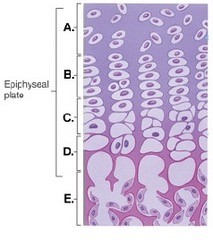Temporal summation is used in the body to
A. increase the amount of force generated by skeletal muscle fibers.
B. activate nearby skeletal muscle fibers, when a muscle fiber is under constant stimulation.
C. maintain constant tension in a muscle fiber every time it contracts.
D. decrease muscle contraction in muscle fibers, to prevent damage to the cells.
E. accomplish all of these functions.
Answer: A
You might also like to view...
 This figure illustrates bone growth in length at the epiphyseal plate. Zone "C" represents
This figure illustrates bone growth in length at the epiphyseal plate. Zone "C" represents
A. zone of hypertrophy. B. zone of resting cartilage. C. bone tissue of the diaphysis. D. zone of proliferation. E. zone of calcification.
Answer the following questions true (T) or false (F)
1. The conduction of an action potential is faster in unmyelinated axons than in myelinated axons. 2. Regeneration of neural tissue in the peripheral nervous system (PNS) is possible only if the neuron's cell body remains intact. 3. During depolarization, the membrane potential becomes more positive.
Define hemolytic disease of the newborn (HDN)
A) Hemolytic disease of the newborn is a congenital defect in the development of the heart. B) Hemolytic disease of the newborn is a result of delayed bone marrow development. C) Hemolytic disease of the newborn is a result of abnormally shaped hemoglobin molecules. D) Hemolytic disease of the newborn is due to a deficiency in the numbers of red blood cells produced, resulting in anemia. E) Hemolytic disease of the newborn is a condition in which maternal Rh antibodies attack and destroy fetal Rh-positive red blood cells, resulting in anemia.
A tissue is a
A. structure contained within a cell. B. lower level of organization than a cell. C. group of organs that performs specific functions. D. group of cells with similar structure and function. E. structure that contains a group of organs.